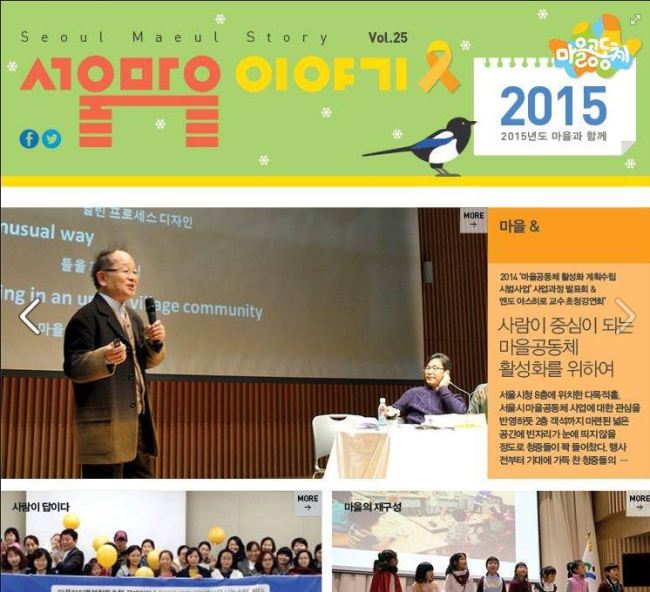Living in the Neighborhoods of a Cosmopolis: A New Community Culture in Seoul
By 김예슬Published : March 25, 2015 - 15:38
Until recently, I used to associate the word “neighborhood” with something grandiose that only dedicated social activists would dare mention. Now, however, numerous neighborhoods have sprung up and continue to flourish throughout Seoul, with parents, amateur singers, young adults, and the like coming together to arrange communal daycare facilities, form neighborhood choirs, and organize community festivals. Thanks to Seoul’s support of the Neighborhood Community Program (NCP), today there are 2,100 neighborhoods in Seoul with 58,800 members who are ushering in a new community culture. By organizing and being active in neighborhoods, locals have come to take firm leadership over their lives, networking with one another and finding ways to improve the quality of life in their communities.
Thriving Leadership and Networks of Local Residents
Neighborhoods are essential to achieving greater public participation in local community affairs. Participation, in turn, is crucial to making each participant feel like an important part of the community. As members of a neighborhood community, regardless of our social and economic backgrounds, we discover new roles to play, and, by implication, new joys and rewards that strengthen our self-esteem. By taking part in local activities, we naturally come to develop a greater interest in our neighborhoods, and by becoming friends with our neighbors, we become more aware of important and pressing social issues. Seoul’s NCP encourages people to become active and leading members of their respective neighborhoods, thereby contributing to the greater public good.

1. Seongmisan Village
The history and legend of Seongmisan Village began when a group of young parents with small children who were living near Seongmisan Mountain began to gather together and discuss communal daycare arrangements. Unable to find nearby daycare centers for their children, the 17 households decided to set up their own daycare center, investing equal sums of money and recruiting and interviewing teachers themselves. As their children grew up and came to require less and less parental attention, these parents continued to hold gatherings regarding other shared interests and concerns. This growing network of neighborly relationships has since diversified into around 70 new neighborhood gatherings, which now include a daycare center, alternative school for local teens, neighborhood café, and a community enterprise.
“Autonomy” and “direct participation” are the two keywords describing the community culture here. All decisions must be made unanimously so as not to exclude anyone and leave no room for conflict in the future. Locals call one another by their nicknames instead of first names or age- or work-related titles. This is another interesting characteristic of the community’s focus on complete equality among all members.
2. Neighborhood Brothers for Culture and the Arts in Gangbuk-gu
Seongmisan Village has become a paradigmatic case of comprehensive neighborhood living. The tendency today, however, is more toward smaller local communities of people that share similar interests in culture and the arts. The Neighborhood Brothers is one such community, organizing diverse workshops, exhibitions, etc. on culture and crafts in a space called the Community Yard. The Community Yard is open to all forms of non-commercial neighborhood activities, such as potluck parties, film screenings, lectures, and various club activities.
3. Issyu: A Shared Space in Doksan-dong, Geumcheon-gu
An abandoned building that once housed a police precinct has now been turned into a “shared space” that is open to all local residents. Locals who were looking for a communal space where they could organize various neighborhood activities finally settled upon this abandoned police building and set about to renovate it. The members of the 11 founding neighborhood gatherings named the renovated space “Issyu: a Shared Space” and established a set of operating principles and rules. Community members clean and maintain the space themselves, and the fact that it is open to all locals and neighborhood activities has brought the neighborhood closer together. As different gatherings interact here, the new space has become a new source of networking and inspiration for the whole community.

4. Communal Funerals
An elderly man was recently found dead, all by himself, in his small, prison cell-like room. His wife and children, from whom he had been estranged for more than a decade, refused to collect the body upon hearing the news of his passing. In such cases, it is customary for a local government organization to collect the deceased and cremate them without a proper burial or memorial. However, thanks to the Warm Company, this deceased man was given a proper two-day funeral service.
Seniors living alone often say that their greatest fear is dying alone, unbeknownst to anybody. They fear that strangers will find their bodies, completely decomposed and unidentifiable.
The Warm Company is a community of people who believe that everyone has an equal right to a dignified death, and that neighborhoods have a duty to provide the minimum necessary arrangements to ensure the dignity in one’s passing. Originally started as a neighborhood funeral service, the Warm Company is now a public-private partnership and a community enterprise that provides funerals, especially for people who die lonely deaths.
The success and evolution of the NCP are evident in the fact that the accumulation of neighborhood experiences and expertise has given way to an increasingly diversified range of neighborhood communities, activities, and public values. In order for each neighborhood community to thrive, every single member must play his or her role, not upon the instruction or command of anyone else, but purely of his or her own free will and commitment to meeting the community’s goals. Through the NCP, more and more citizens in Seoul are breaking out of their hard shells of individualism and isolation and transforming into warm and friendly neighbors who are willing to help one another, and are all the happier for it.
By online news team(onlinenews@heraldcorp.com)


![[Exclusive] Korean military set to ban iPhones over 'security' concerns](http://res.heraldm.com/phpwas/restmb_idxmake.php?idx=644&simg=/content/image/2024/04/23/20240423050599_0.jpg&u=20240423183955)




![[Pressure points] Leggings in public: Fashion statement or social faux pas?](http://res.heraldm.com/phpwas/restmb_idxmake.php?idx=644&simg=/content/image/2024/04/23/20240423050669_0.jpg&u=)










